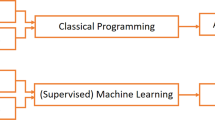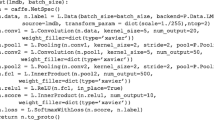Abstract
In this chapter, we describe the process of obtaining medical imaging data and its storage protocol. The authors also explain in a step-by-step approach how to extract and prepare the medical imaging data for machine learning algorithms. And finally, the process of building and assessing a convolutional neural network for medical imaging data is illustrated.
Access this chapter
Tax calculation will be finalised at checkout
Purchases are for personal use only
Similar content being viewed by others
References
Langlotz CP, et al. A roadmap for foundational research on artificial intelligence in medical imaging: from the 2018 NIH/RSNA/ACR/The Academy Workshop. Radiology. 2019;291(3):781–91.
Erickson BJ, Korfiatis P, Akkus Z, Kline TL. Machine learning for medical imaging. Radiographics. 2017;37(2):505–15.
Willemink MJ, et al. Preparing medical imaging data for machine learning. Radiology. 2020;295(1):4–15.
Saboori M, Ahmadi J, Farajzadegan Z. Indications for brain CT scan in patients with minor head injury. Clin Neurol Neurosurg. 2007;109(5):399–405.
Smits M, et al. External validation of the Canadian CT Head Rule and the New Orleans Criteria for CT scanning in patients with minor head injury. JAMA. 2005;294(12):1519–25.
Chilamkurthy S, et al. Deep learning algorithms for detection of critical findings in head CT scans: a retrospective study. Lancet. 2018;392(10162):2388–96.
Chilamkurthy S, et al. Development and validation of deep learning algorithms for detection of critical findings in head CT scans. 2018. arXiv preprint arXiv:1803.05854.
Keshavamurthy KN, et al. Machine learning algorithm for automatic detection of CT-identifiable hyperdense lesions associated with traumatic brain injury. Med Imaging 2017 Comput Diagn. 2017;10134(1):101342G. https://doi.org/10.1117/12.2254227.
Gong T, et al. Classification of CT brain images of head trauma. Lect Notes Comput Sci (including Subser Lect Notes Artif Intell Lect Notes Bioinformatics). 2007;4774 LNBI:401–8. https://doi.org/10.1007/978-3-540-75286-8_38.
Lee B, Newberg A. Neuroimaging in traumatic brain imaging. NeuroRx. 2005;2(2):372–83.
Mustra M, Delac K, Grgic M. Overview of the DICOM standard. In: 2008 50th International Symposium ELMAR, vol. 1; 2008. p. 39–44.
Mildenberger P, Eichelberg M, Martin E. Introduction to the DICOM standard. Eur Radiol. 2002;12(4):920–7.
Gibaud B. The DICOM standard: a brief overview. In: Molecular imaging: computer reconstruction and practice. New York: Springer; 2008. p. 229–38.
Huang J, Ling A, Summers RM, Yao J. Integration of PACS and CAD systems using DICOMDIR and open-source tools. In: Medical imaging 2013: advanced PACS-based imaging informatics and therapeutic applications, vol. 8674; 2013. p. 86740V.
Villegas R, Montilla G, Villegas H. A software tool for reading DICOM directory files. Int J Healthcare Inf Syst Informatics. 2007;2(1):54–70.
Mason D, et al. pydicom/pydicom: pydicom 2.1.1; 2020. https://doi.org/10.5281/ZENODO.4248192.
Caswell TA, et al. matplotlib/matplotlib: REL: v3.3.1; 2020. https://doi.org/10.5281/ZENODO.3984190.
Beazley DM. Python essential reference. Boston: Addison-Wesley Professional; 2009.
Dalcin LD, Paz RR, Kler PA, Cosimo A. Parallel distributed computing using Python. Adv Water Resour. 2011;34(9):1124–39.
Wang H, Li S, Song L, Cui L. A novel convolutional neural network based fault recognition method via image fusion of multi-vibration-signals. Comput Ind. 2019;105:182–90.
Howard AG. Some improvements on deep convolutional neural network based image classification. arXiv Prepr. arXiv1312.5402; 2013.
Jifara W, Jiang F, Rho S, Cheng M, Liu S. Medical image denoising using convolutional neural network: a residual learning approach. J Supercomput. 2019;75(2):704–18.
Bradski G. The OpenCV library. Dr Dobbs J Softw Tools. 2000;120:122–5.
Howse J, Joshi P, Beyeler M. Opencv: computer vision projects with python. Birmingham: Packt Publishing Ltd; 2016.
Pedregosa F, et al. Scikit-learn: machine learning in {P}ython. J Mach Learn Res. 2011;12:2825–30.
Krizhevsky A, Sutskever I, Hinton GE. Imagenet classification with deep convolutional neural networks. In: Advances in neural information processing systems; 2012. p. 1097–105.
Zeiler MD, Fergus R. Visualizing and understanding convolutional networks. In: European conference on computer vision; 2014. p. 818–33.
Simonyan K, Zisserman A. Very deep convolutional networks for large-scale image recognition. arXiv Prepr. arXiv1409.1556; 2014.
Szegedy C, et al. Going deeper with convolutions. In: Proceedings of the IEEE conference on computer vision and pattern recognition; 2015. p. 1–9.
He K, Zhang X, Ren S, Sun J. Deep residual learning for image recognition. In: Proceedings of the IEEE conference on computer vision and pattern recognition; 2016. p. 770–8.
Hara K, Saito D, Shouno H. Analysis of function of rectified linear unit used in deep learning. In: 2015 International Joint Conference on Neural Networks (IJCNN); 2015. p. 1–8.
Scherer D, Müller A, Behnke S. Evaluation of pooling operations in convolutional architectures for object recognition. In: International conference on artificial neural networks; 2010. p. 92–101.
Author information
Authors and Affiliations
Editor information
Editors and Affiliations
Rights and permissions
Copyright information
© 2022 The Author(s), under exclusive license to Springer Nature Switzerland AG
About this paper
Cite this paper
Mohamed, M.A.K., Alamri, A., Smith, B., Uff, C. (2022). Applying Convolutional Neural Networks to Neuroimaging Classification Tasks: A Practical Guide in Python. In: Staartjes, V.E., Regli, L., Serra, C. (eds) Machine Learning in Clinical Neuroscience. Acta Neurochirurgica Supplement, vol 134. Springer, Cham. https://doi.org/10.1007/978-3-030-85292-4_20
Download citation
DOI: https://doi.org/10.1007/978-3-030-85292-4_20
Published:
Publisher Name: Springer, Cham
Print ISBN: 978-3-030-85291-7
Online ISBN: 978-3-030-85292-4
eBook Packages: MedicineMedicine (R0)




